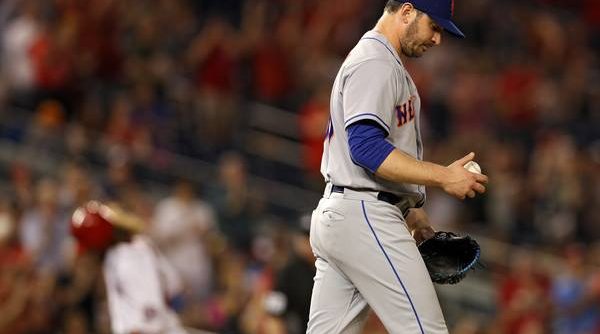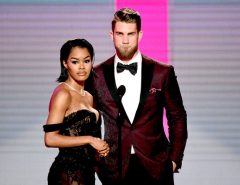Thanks to an intradivision rivalry and a shared Tommy John history, Matt Harvey and Stephen Strasburg will be forever linked. Since Matt Harvey fancies himself as the Dark Knight, Batman v. Superman: Dawn of Justice dictates that Stephen Strasburg is Superman. Which, sidebar, is that a good thing? I never saw it so I don’t even know it was it really a rivalry. I’m assuming Batman and Superman just end up as buddies at the end so they can make their Justice League sequel(s)? Is that why it sucked? Should really have done my research before writing this piece, huh? Anyways, back on the field, it was Superman/Strasburg who took round two of the 2016 Harvey v. Strasburg matchup Tuesday night.
Prior to Harvey’s start on Tuesday, the Mets announced the decision to keep Harvey pitching on his normal schedule. Usually this isn’t anything a team needs to announce. “Hello, pitcher X will be pitching exactly when we expected him to” isn’t something that teams usually do. But Harvey had been struggling through his previous starts in 2016 and some were wondering if the Mets would let him keep pitching. Of course, these struggles came on the heels of Harvey’s 2015 season that famously saw him go past the recommended innings limit for a pitcher post-Tommy John surgery. So, after ignoring doctor’s orders to take it easy on him, the Mets are now wondering if they pushed him too hard last year and are paying the price in 2016.
Without access to Harvey’s medical records, it’s impossible to say for sure if those innings in 2015 have taken their toll on Harvey or his reconstructed elbow. He’s 10 starts into his 2016 season and his 6.15 ERA combined with dropping strikeout rates and rising walk rates certainly suggests something is amiss. Harvey is known for his overpowering velocity but it has been obvious he doesn’t quite have his usual pop so far in 2016. After averaging 96 MPH on his fastball last season, Harvey has averaged only 94 MPH this season. His fastball velocity has jumped around from start to start — he averaged over 96 MPH on May 8th versus the Padres, for example — but he hasn’t been able to sustain the power we were so used to seeing last year.
That lack of velocity does appear to have contributed to Harvey’s struggles. In the past, Harvey has lived in the upper half of the zone with his fastball. While usual baseball thinking commands pitchers to throw low in the zone, Harvey has had success pitching up in the zone where hitters really struggle to square up his 96+ MPH fastball close to the letters. In 2016, he hasn’t been able to get away with that approach. Those high fastballs during his 2013 and 2015 seasons were inducing batters to swing and miss over 11% of the time. In 2016, they were whiffing only 9% of the time coming into Tuesday’s game, and Harvey registered only one swing and miss on his fastball Tuesday. After hitting only .234 against Harvey’s fastball in the past, hitters in 2016 were raking at a .331 clip coming into the game on the 94 MPH version of his fastball. Then the Nationals tacked on another five hits versus the fastball, including three home runs.
While Harvey has struggled with the fastball, it’s the slider that is really killing him. Over the last two seasons, it was a practically unhittable pitch. Opponents batted only .194 on the slider and whiffed nearly 18% of the time against the pitch. In 2016, Harvey is still generating his share of swings and misses with the slider but was getting pounded to the tune of a .405 batting average and a .297 ISO coming into the Nationals matchup. Holy smokes, Batman!
Mets pitching coach Dan Warthen is famous for his “Warthen Slider.” Warthen teaches his pitchers to focus on throwing sliders with more velocity and worry less about extreme movement on the pitch, the goal being to get just enough movement on the pitch to mess with the hitter’s ability to square it up but making it a little easier on the pitcher’s arm. In 2015, Harvey’s slider resembled the ideal Warthen Slider, hard with tight movement. In 2016, though, his slider has been a touch slower and a touch loopier and looks more like his 2013 slider than the 2015 version.
Of course, Harvey’s slider was an effective pitch in both 2013, the loopier version, and 2015, the Warthen version, so it’s unlikely the change in movement has driven his struggles this season. No, the real reason the slider has gotten clobbered is that Harvey hasn’t been able to locate the pitch. Harvey usually buries the pitch low to his glove side; getting some called strikes right on the black or fooling batters to swing over the top of the pitch. This season Harvey has been all over the place with his slider, throwing it in the zone more often and paying the price for it.
So Harvey is throwing slower, his slider isn’t as tight and he’s struggling to locate his best breaking ball. Sure seems like Harvey is suffering the after-effects of pitching so long in 2015. On the other hand, there haven’t been any reports of injury struggles out of the Mets’ camp, aside from Harvey’s struggles with learning when to hit the restroom. While it’s impossible to rule out the impact of pitching so much last season, Harvey has also been experiencing some pretty bad luck. His BABIP allowed of .374 is the third-highest BABIP allowed in all of baseball among starting pitchers. Harvey is somewhat to blame for that BABIP as he’s allowed a higher rate of line drives in 2016, but the Mets have fielded one of the worst defenses in baseball this season and that’s certainly not helping him out.
On top of that, Harvey has been pretty terrible at stranding runners due to some unfortunate timing. The so called clustering of hits is usually out of a pitcher’s control. Allow six hits scattered over six innings and he pitched a gem. Give up four of those six hits in one inning and he probably goes home a loser. The easiest way to measure this is strand rate, the percent of batters who reach base against a pitcher but fail to ever score. The league average for the 2016 season for starting pitchers is 72%. Harvey, being a far above average pitcher over the course of his career, has a career strand rate closer to 80%. So far in 2016? He’s stranding runners only 64% of the time. The reason for his struggles stranding opponents on the base paths? He’s been allowing a disproportionate number of hits with runners on base. Prior to this season, Harvey held hitters to a .207 batting average with the bases empty and a .240 average with runners on base. In 2016, opponents are batting .298 with the bases empty and a scorching .348 with runners on base. Limit those situations to instances with runners in scoring position and Harvey has been allowing hits at a .362 clip. Essentially, opponents have been hitting like Daniel Murphy against Harvey when runners have been on base. Granted, batters are hitting better against Harvey this season but there is no reason to think they will continue to hit so much better with runners in scoring position. If Harvey had experienced his usual clustering of hits, his ERA is probably closer to 4.00 than 6.00 and Mets fans wouldn’t be clamoring for Harvey to be cut. Well, maybe Mets fans would still be out for blood, but the baseball world wouldn’t be as obsessed with Harvey’s struggles as they are now.
As much fun as it has been for Nationals’ fans to watch Harvey struggle and laugh at the Mets attempts to solve Harvey’s struggles with a literal dumpster fire, don’t write him off just yet. It certainly looks like the extra stress on Harvey’s arm last year has played a part but he’s also been on the wrong side of the baseball gods.
Nationals fans are riding high after claiming another win in a Harvey v Strasburg showdown. Don’t forget, though, that only a year ago Stephen Strasburg was sporting a 6.55 ERA. He seemed to come out of that rough stretch just fine so I’m not ready to write off Harvey just yet.





Leave a Reply